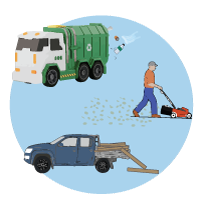|
|
MechanicalCars, trucks, tractors, slashers, bicycles and even lawnmowers break up waste and move it through the environment. For example, collection of kerbside waste bins by rubbish trucks can result in plastic bags, paper and other items blowing out and contributing to residential and roadside litter[3]. It highlights the importance of roads in the mechanical distribution of waste pollution[1]. MechanicalMechanical processes transport waste pollution through the environment, and together with wind, water (i.e. rain) and sunlight (i.e. breakdown of materials making them more transportable), they they also tend to break up persistent material (like plastic) into smaller pieces. These pieces remain in the environment as they do not break down into organically usable forms. For example, a plastic water bottle fragments into smaller and smaller pieces, going from macroplastics, to microplastics and nanoplastics. At each stage, these pose different threats to animals and ecosystems. A study found the presence of microplastics in road dust along an urban to rural transect within South-East Queensland. Concentrations ranged from ~0.5 mg/g in a rural site to 6 mg/g in Brisbane city, with 29% each consisting of polyvinyl chloride and polyethylene terephthalate. There was a strong relationship between the concentration of microplastics in road dust and the volume of vehicles on the road[2]. 
Waste made of bio/photodegradable material breaks down completely and decomposes into natural elements. 
References
Last updated: 23 April 2025 This page should be cited as: Department of Environment, Science and Innovation, Queensland (2025) Mechanical, WetlandInfo website, accessed 8 May 2025. Available at: https://wetlandinfo.des.qld.gov.au/wetlands/management/pressures/litter-illegal-dumping/pathways/mechanical/ |

 — Department of the Environment, Tourism, Science and Innovation
— Department of the Environment, Tourism, Science and Innovation


